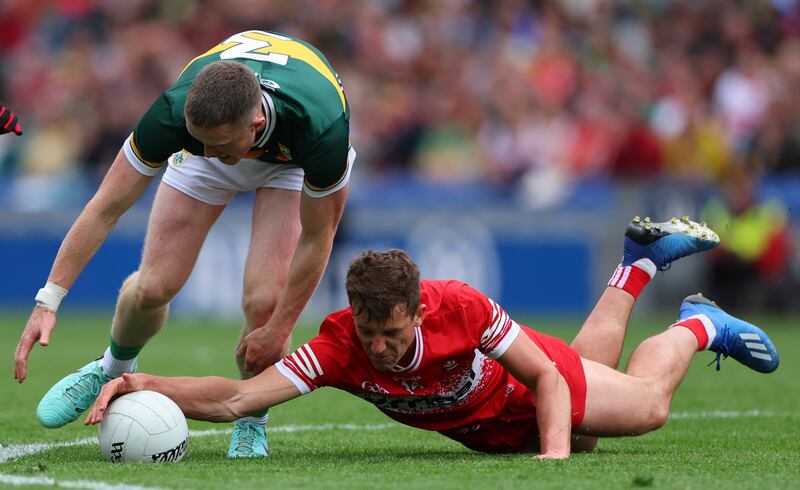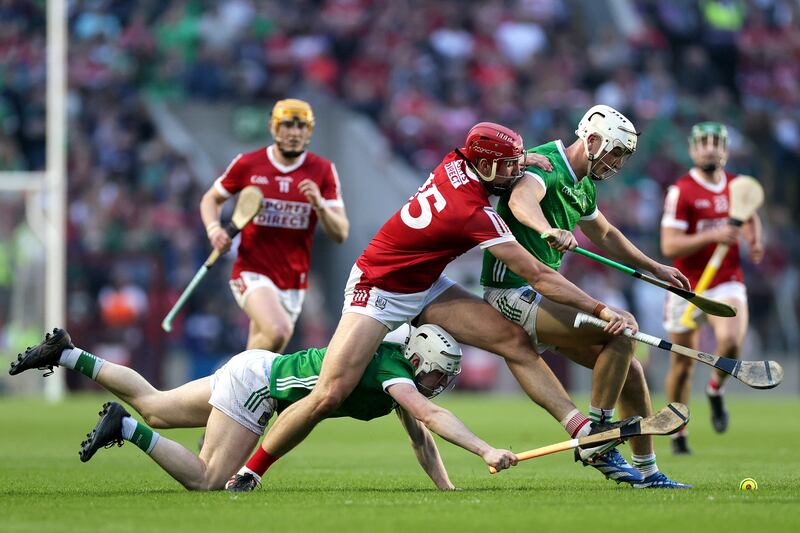There was much ribaldry in the media zone on Sunday about the scale of the task confronting Jim Gavin’s football think tank. Derry were scared of their newly hospitable defence whereas Kerry were scared of their opponents’ pace should they ever get turned over by them.
The resulting ‘spectacle’ of low percentage risk was so short on contests and even occasional risk-reward gambles that you could have settled it by playing the last 10 minutes as a stand-alone test.
In the end, Kerry produced enough to become the fourth team to beat Derry in the championship and, coincidentally, will join the other three in the All-Ireland semi-finals.
Then again, it’s the old issue: do amateur teams and their players actually have any obligation to serve up entertaining matches? Is there duty of care, beyond getting the result? It’s hard to argue that there is, however disagreeable we all may find watching it.
READ MORE
The GAA though does have a sizeable interest in the matter given the ailing attendances at the football championship this year, most alarmingly the fall-off in crowds following Dublin, as evidenced in no more than 20,000 going to the county’s Leinster matches.
Reasons for declining numbers have been freely advanced. The non-functioning nature of the Leinster and Munster championships has taken its toll on public interest.
Even Louth, in some ways the team of the season having reached a first All-Ireland quarter-final, could excite no enthusiasm in the county for their provincial final rematch with Dublin – the supporters, fearing a repeat of their 21-point hiding the year before, stayed away as, largely, did the champions’ followers.
The attendance of 23,113 was the lowest in nearly 80 years.
Lack of jeopardy is also mentioned. It’s harder to get knocked out of the group stages than to advance but last weekend was a second successive round of sudden death and yet culminated in the wrong type of record.
The All-Ireland quarter-finals for the first time in the 24 years of their existence failed cumulatively to break 100,000 spectators, drawing 49,896 and 47,406 on Saturday and Sunday, respectively.

Quarter-finals have over the years become less and less well-contested. Each match at the weekend had a long odds-on favourite and although Galway demonstrated the occasional folly of these indicators, the other three delivered predicted results.
The sad fact about Dublin is that they were a more reliable draw when trying, and failing, to get to All-Irelands in the 2000s than they have been in the 2020s, looking to add Sam Maguires to an already impressive pile. Until 2010, the decade when it all took off, the county would regularly attract 70,000-plus to Croke Park for All-Ireland quarter-finals and beyond.
Apart from last year’s capacity crowd for the Mayo quarter-final, those sorts of numbers have proved hard to hit in more recent times.
Writing on social media about the weekend’s matches, former GAA president and recently re-elected MEP, Seán Kelly had this to say.
“I presume players are enjoying playing ‘modern’ Gaelic football but, sadly, for more and more people I speak to, it’s not a ‘spectator’ sport anymore. Surgery needed and quick.”
The Football Review Committee, which is ‘sandboxing’ various rules interventions this month, does address that issue in its headline terms of reference, which reads: ‘Providing the best possible games experience for players and spectators’.
Yet after his team’s thrilling takedown of champions Dublin on Saturday, Galway manager Pádraic Joyce made an obvious point.
“I’m sure people talk about rule changes being made in football but is there a need after watching a game like that? I’m not so sure.”
These aesthetic concerns are, however, only half of the consideration. Lack of competitiveness is the other half. Back in the 1980s when Kerry were in their pomp, hardly anybody was interested in seeing their county get fed into the grinder no matter how high-scoring and gifted the opposition.
There was every third year when the Munster champions played Leinster and that somewhat elevated jeopardy would bring bigger crowds out, particularly for Dublin and Kerry although the Dubs were well into a 34-year sequence of losing every time they faced their old rivals.

For the other years when the semi-final rivals were Armagh and Monaghan, Galway or even Mayo, attendances averaged 20,787 – sinking as low as 17,523 in 1984 for Kerry-Galway.
This month, the desire for novelty and competition should be well indulged. It is difficult to think of a year when the four semi-finalists had such presentable claims on an All-Ireland.
Will that bring out the crowds? Who knows but if not, it has to be reflective of a malaise in the game.
The perennial comparison with hurling is relevant. Allowing for its relative embrace of a possession-based game, hurling is still about the contest for possession even if the intention is to condition that contest to give your team maximum advantage.
Limerick are as dominant as Dublin were in one respect – the accumulation of provincial and All-Ireland silverware – but from another perspective, they have had to be more accountable in Munster where – for whatever reason – the competition has been more intense than at All-Ireland level.
In five years of round-robin championship schedules, the serial champions have played 20 matches and failed to win eight, a failure rate of 40 per cent that has brought about some terrific matches, like this year’s Cork-Limerick encounter, which is being revisited in next Sunday’s All-Ireland semi-final and is expected to go close to a capacity.
This is after a season of unexpected results in both provinces and record-extending revenues in the Munster championship.
Kerry-Derry may have been proof that even tightly contested football matches can be aesthetically unimpressive but the nature of sport holds little interest in skills and thrills outside a suitably competitive environment.
email: sean.moran@irishtimes.com

















